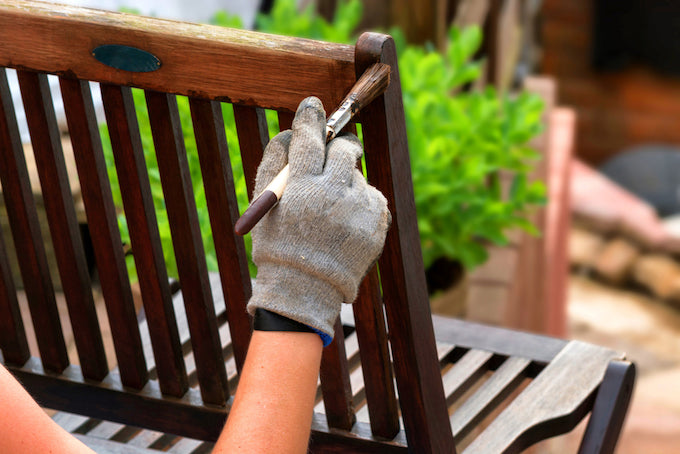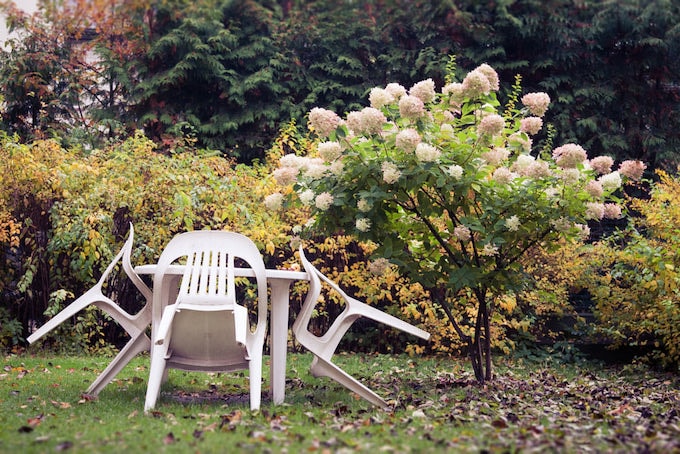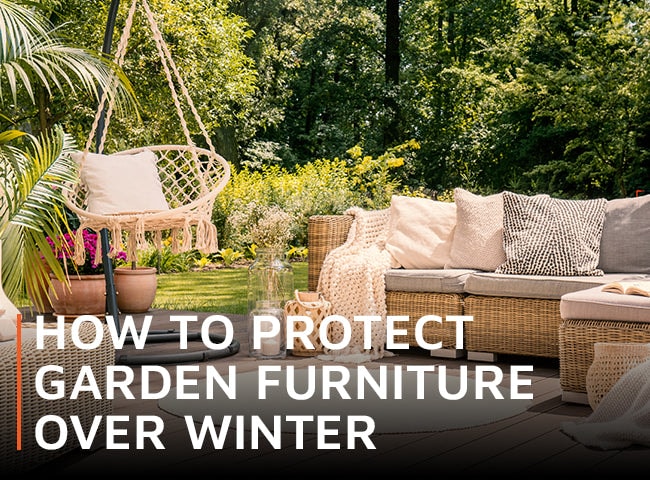Look after your garden furniture and it will last you for years to come. Here’s how to protect and store your garden furniture over winter, so you can enjoy it summer, after summer, after summer.
Cleaning and protecting garden furniture
Whether you’re planning to store your garden furniture inside a wooden or plastic shed, or leave it outside over the winter, cleaning and protecting it from the elements will help it last longer and stay looking beautiful
How you do this depends on what your furniture is made from. Read on for the specific care instructions for all types of garden furniture.
How to care for wooden garden furniture

Image: Charles Taylor Eight Seater Rectangular Dining Bench Set with Parasol from Waltons
Wooden garden furniture requires the most maintenance and protection every year. Here are the simple steps to follow if you want to keep your wooden outdoor furniture in tip-top condition.
1. Clean it
All wooden furniture will appreciate a good clean once a year to remove dirt, algae, bird droppings and lichens. If you’re leaving your wooden furniture outside over winter, you might think it’s not worth doing any cleaning during the wetter months but dirt actually holds onto extra moisture. This means that dirty furniture will stay damper all season long and be more susceptible to decay than clean furniture, which gets the chance to dry out on sunnier days.
Even if you’re going to be storing your wooden furniture in a shed or garage, cleaning it first will make sure that it stays nicely dry while in storage, and prevents dirt from drying into the wood.
Wash your wooden furniture with warm, soapy water and a brush. Let it dry completely before giving it a light sandpaper.
2. Treat it

Image: JFs Pic S. Thielemann/Shutterstock
Hardwood - including teak, acacia, oak and eucalyptus - doesn’t need to be treated beyond a good clean. It will weather to a silvery colour over time, but if you want to maintain its original colour, treating it with teak oil once a year will do the trick.
Softwoods, like pine, will need to be treated with a preservative, wood paint or oil to protect the wood. Paint your chosen product onto furniture using a clean brush. Make sure you tilt the furniture to treat underneath the legs - those areas that are in contact with the ground are prime spots for moisture absorption and decay. Let the first coat of preservative or paint dry thoroughly before adding a second coat.
3. Fix it
Take this opportunity to check for missing and loose screws. If you need to replace any, opt for brass screws which won’t rust.
How to care for wrought iron and steel furniture

Image: Sergey Novikov/Shutterstock
Cleaning iron and steel furniture thoroughly once a year gives you the perfect opportunity to find any rust spots before they grow beyond repair. Wash with soap and water, using a scrubbing brush or cloth, and rinse the soap off with clean water.
If you can see any rust spots, treat them now to stop them getting worse. Sand the rust off with steel wool or hand sander - depending on how big the area is. Clean the area again and fill any holes with an epoxy filler. Sand once more and, finally, prime and paint the metal furniture to protect it and restore it to its former beauty.
How to care for aluminium garden furniture

Image: aurelie le moigne/Shutterstock
Although aluminium garden furniture won’t rust, it still needs looking after over winter. Use a soft-bristled brush to remove dirt or leaves. Next, wash remaining dirt and stains with hot water and soap. Rinse with clean water and apply water and vinegar using a soft cloth to polish the metal.
Don’t use anything abrasive as it will damage the surface of the aluminium. You can finish off your maintenance with a coat of car wax for extra protection.
How to care for plastic garden furniture

Image: Katrin Kasper/Shutterstock
Plastic furniture is inexpensive, easy to move around and very durable. But it can quickly look grubby unless looked after. Wash your plastic garden furniture with hot water and soap or detergent, or blast it with a pressure washer. Don’t use anything abrasive to scrub your plastic furniture as this will damage the surface.
If you have white plastic furniture that’s looking stained, you can bleach it - just be sure to protect your hands with gloves.
Whatever colour your plastic furniture is, finish off your cleaning regime with a coat of car wax to bring up the shine.
How to care for rattan and wicker garden furniture

Image: Ground Picture/Shutterstock
The woven nature of rattan and wicker garden furniture requires a little extra cleaning care. First, vacuum the piece with the soft brush attachment to remove dirt and dust from between the weave. Next, wipe with a damp cloth to remove any remaining dirt or mildew.
Rattan and wicker furniture should ideally be stored either indoors or a secure garden store, or at least covered properly over winter. Never leave rattan garden furniture uncovered outdoors all year round.
Storing your garden furniture
Now your garden furniture is clean and dry, it’s time to think about storage over the winter. Your options are:
- Storing it inside a garage or shed
- Protecting it with special covers
- Moving it to a sheltered position
For tips on each of these solutions, read on...
1. Store garden furniture in a garage or shed

Image: Canopia by Palram 6 x 10 Skylight Plastic Shed - Amber from Waltons
Most garden furniture will be happier stored inside over winter. Many pieces, like folding seats, sun loungers, and folding tables are collapsable to help make storage easier. Others are designed to be stackable to minimise the storage space they require.
If you have room in your garage or garden shed, put clean and dry garden furniture away during the wetter months. If you don’t have space to store garden furniture in your current garden buildings, consider investing in a plastic storage shed specifically for this purpose.
Iron or steel furniture should be stored inside if possible. Likewise barbecues and garden grills should be cleaned and packed away for the winter.
Natural wicker and natural rattan furniture will not last very long if it is left outside during the wetter winter months. Fortunately, much rattan garden furniture today is made of more practical rattan-effect plastic and can be left outside with adequate coverings.
Cushions and other soft garden-furnishings should always be cleaned and stored over the winter months. Check the care instructions for each piece. Machine wash those pieces that can be washed, and sponge down those that you can’t. Allow cushions and covers to dry completely before storing them somewhere indoors or under cover where they won’t be found by mice.
All furniture and cushions stored in sheds and garages should be checked regularly to make sure it’s still dry.
2. Protect outdoor furniture with special covers

Image: Shutterstock
If you’re leaving your garden furniture outside during the winter, you’ll want to invest in some appropriate covers to protect it from the worst weather.
Plastic garden furniture, in particular, will become brittle and deteriorate if left out in sunlight for more than a few weeks at a time - even over the winter. Good-fitting covers help prolong the life of your plastic garden furniture.
Rattan-effect furniture will also benefit from good covering during the winter months. Choose waterproof covers to guarantee the highest level of moisture protection for your rattan garden furniture.
Before covering furniture, remove any soft furnishings and seat pads. Then, make sure it’s clean and bone dry and ensure there is adequate ventilation so that air can circulate. This means that if any moisture does get underneath the cover, it will be able to escape on a dry day.
3. Move outdoor furniture to a sheltered position

Image: Charles Taylor Dorset Three Seat Swing with Cushions from Waltons
Whether you choose to keep your garden furniture covered or uncovered during the winter, moving it to a more sheltered part of your garden will further protect it from wind and rain.
If possible, move your garden furniture off the grass and onto a flat, concrete or paved, surface, to lessen exposure to moisture from below. If your wooden furniture must stay on the lawn, remember to treat the feet and legs with preservative and place a flat stone under each foot to raise it off the wet grass.
Lighter furniture is prone to being blown over in strong winds and can be easily damaged and cause damage to your garden. Moving it to a sheltered spot will help reduce the danger of this.
So there you have it - everything you need to know about looking after garden furniture in the wetter months. Come spring, when it’s time to enjoy that furniture again, you’ll be glad you made the effort.
Lead image: Shutterstock




